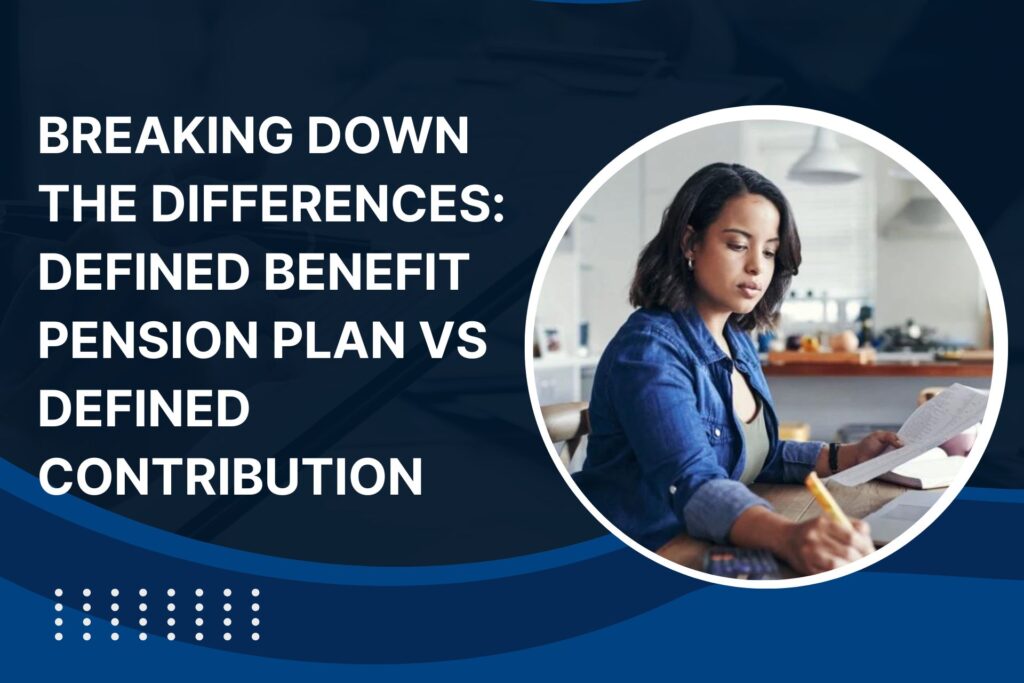Introduction: Defined Benefit Plan vs Defined Contribution Plan
Many individuals struggle to navigate the complexities of retirement planning and understanding the various options available to them. In this article, we will break down the key differences between defined benefit plan vs defined contribution plan, providing you with the knowledge you need to make informed decisions about your financial future. Whether you’re a young professional just starting your career or a seasoned worker nearing retirement, understanding these two types of retirement plans is essential.
What is a Defined Benefit Pension Plan?
A defined benefit pension plan is a retirement plan in which an employer promises to pay employees a predetermined benefit amount upon retirement. The benefit is typically calculated based on a formula that considers factors such as the employee’s salary, years of service, and age at retirement. The employer bears the investment risk and ensures that there are sufficient funds to cover the promised benefits, providing employees with a predictable income stream during retirement.
What is a Defined Contribution Pension Plan?
A defined contribution pension plan, also known as a DC plan, is a retirement plan in which both the employer and employee contribute funds toward the employee’s retirement savings. The contributions are invested in individual accounts, managed by the employee or through a selected investment provider. The ultimate retirement benefit is determined by the performance of the investments in the account. Unlike defined benefit plans, the benefit amount is not predetermined and can vary based on investment returns.
Key Differences Between Defined Benefit Plan and Defined Contribution Plan
Feature
Defined Benefit Pension Plan
Defined Contribution Plan
Predictability of Income
Provides a predictable income stream during retirement
Does not guarantee a specific benefit amount
Investment Risk
Employer bears the investment risk
Employee bears the investment risk
Control over Investments
Limited control for employees
Employees can choose and manage their investments
Portability
Typically tied to a specific employer
Portable, allowing employees to take savings if they change jobs
Responsibility for Investment Decisions
Employer manages investments
Employees must actively manage their retirement savings
Potential for Higher Returns
Provides a predetermined income stream
Potential for higher returns based on investment performance
Calculate your Retirement Plans Today!
Calculate Now!Advantages and Disadvantages:
The choice between a defined benefit plan vs defined contribution plan depends on your personal preferences, financial goals, and risk tolerance. Here are some key questions to consider:
Advantages of a Defined Benefit Pension Plan
- Predictable Income: Provides a predetermined benefit amount, allowing for better financial planning.
- Employer Responsibility: Employer manages investments and ensures sufficient funds.
- Lifetime Income: Often provides a lifetime income stream.
Disadvantages of a Defined Benefit Pension Plan:
- Lack of Control: Employees have limited input in investment decisions.
- Potential for Benefit Reductions: Benefits can be reduced if the plan’s investments underperform.
- Limited Portability: Tied to a s
Advantages of a Defined Contribution Pension Plan
- Investment Control: Employees can choose and manage their investments.
- Portability: Employees can take their savings with them when changing jobs.
- Potential for Higher Returns: Investments can yield higher returns, increasing retirement savings.
Disadvantages of a Defined Contribution Pension Plan:
- Investment Risk: Employees bear the risk of poor investment performance.
- Uncertain Retirement Income: Retirement income depends on investment performance and can fluctuate.
- Responsibility for Investment Decisions: Employees must make informed investment choices, which can be daunting for those lacking investment knowledge.
Choosing the Right Plan for You: Defined Benefit Plan vs Defined Contribution Plan
The choice between a defined benefit plan vs defined contribution plan depends on your personal preferences, financial goals, and risk tolerance. Here are some key questions to consider:
- Do you prefer a predictable income stream or the potential for higher returns?
- Are you comfortable taking on investment risk?
- How long do you anticipate staying with your current employer?
- Do you have the knowledge and interest to manage your investments actively?
- Are you willing to take responsibility for investment decisions and stay informed about market trends?
Conclusion
Defined benefit plan vs defined contribution plan offer distinct advantages and disadvantages. Defined benefit plans provide a predictable income stream during retirement, while defined contribution plans shift the investment risk to the employee. The choice between the two depends on factors such as your retirement goals, risk tolerance, and investment knowledge.
Regardless of the plan you choose, it’s important to start saving for retirement as early as possible. The earlier you start, the more time your investments have to grow and compound. Additionally, regularly reviewing and adjusting your retirement plan as your circumstances change is crucial for long-term financial security.
Remember, retirement planning is a complex process, and it’s always a good idea to seek advice from a qualified financial advisor who can help you navigate the options and make the best choices for your financial well-being. So, whether you opt for a defined benefit pension plan or a defined contribution plan, take control of your retirement planning today and secure a bright financial future for yourself.
SHARE THIS POST
Generation X and Retirement: Discover smart strategies to avoid costly mistakes and secure your future with effective financial planning.
Discover the key differences between a Defined Benefit Plan vs 401k, and find the best pension plan for small business owners.
Planning for retirement in USA involves Social Security, inflation strategies, and choosing the best states, ensuring a secure financial future.
Learn effective strategies to maximize your 401k for a secure retirement. Discover tips on matching, investment choices, and catch-up contributions!


